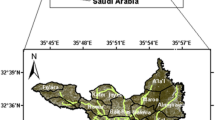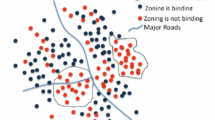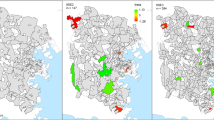Abstract
This paper develops an estimation strategy for and then applies a spatial autoregressive multinomial probit model to account for both spatial clustering and cross-alternative correlation. Estimation is achieved using Bayesian techniques with Gibbs and the generalized direct sampling (GDS). The model is applied to analyze land development decisions for undeveloped parcels over a 6-year period in Austin, Texas. Results suggest that GDS is a useful method for uncovering parameters whose draws may otherwise fail to converge using standard Metropolis-Hastings algorithms. Estimation results suggest that residential and commercial/civic development tends to favor more regularly shaped and smaller parcels, which may be related to parcel conversion costs and aesthetics. Longer distances to Austin’s central business district increase the likelihood of residential development, while reducing that of commercial/civic and office/industrial uses. Everything else constant, distances to a parcel’s nearest minor, and major arterial roads are estimated to increase development likelihood of commercial/civic and office/industry uses, perhaps because such development is more common in less densely developed locations (as proxied by fewer arterials). As expected, added soil slope is estimated to be negatively associated with residential development, but positively associated with commercial/civic and office/industry uses (perhaps due to some steeper terrains offering view benefits). Estimates of the cross-alternative correlations suggest that a parcel’s residential use “utility” or attractiveness tends to be negatively correlated with that of commercial/civic, but positively associated with that of office/industrial uses, while the latter two land uses exhibit some negative correlation. Using an inverse-distance weight matrix for each parcel’s closest 50 neighbors, the spatial autocorrelation coefficient is estimated to be 0.706, indicating a marked spatial clustering pattern for land development in the selected region.








Similar content being viewed by others
Notes
A total of \((J+1)\) alternatives is considered with indices \(\{j=0,\,1,\ldots ,J\}\), where {\(j\,{=}\,0\)} is the base alternative for identification purposes. Thus, \(y_{ij}^*\) is the difference between the jth alternative’s utility and that of the base alternative.
\(D_{ij} =\frac{1}{d_{ij} }\) if \(d_{ij} <d_\mathrm{max} ,\,\hbox {and}\,D_{ij} =0\,\hbox {if}\,d_{ij} \ge d_\mathrm{max} ,\hbox { where }d_\mathrm{max} \) is the threshold distance associated with the \(q\)th-nearest neighbor to geographic unit \(i)\). For the \(J\,{=}\,2\) case, the \(i\)th and \((i+1)\)th row of \({\tilde{W}}\) is expressed as: \(\,{\tilde{W}}_i =\small {\left( {{\begin{array}{ccccccc} {W_{i1} }&{} 0&{} {W_{i2} }&{} 0&{} \ldots &{} {W_{in} }&{} 0 \\ 0&{} {W_{i1} }&{} 0&{} {W_{i2} }&{} \ldots &{} 0&{} {W_{in} } \\ \end{array} }} \right) }.\)
The Wishart distribution is any of a family of probability distributions defined over symmetric and nonnegative-definite matrix-valued random variables (i.e., “random matrices”). It is particularly valued in Bayesian inferences, since it leads to a conjugate prior for the inverse of the covariance matrix of a multivariate normal distribution (Robert and Casella 2004).
Fifty nearest neighbors were used because this number delivered the best results among the four cutoff values attempted: 30, 50, 100, and 150. A weight matrix’s specification is not so relevant for inference, since most forms of connectivity between observations (directly or via neighbors of neighbors, for example) deliver very similar direct and indirect effects for both continuous (LeSage and Pace 2012) and binary responses (Wang et al. 2013).
For example, longer parcels (with a high aspect ratio) and those with an “L” shape will have larger PeriArea values.
The Geweke diagnostic tests for equality of the average estimates emerging from the first 10 % and the final 50 % of the Markov chain values. This test statistic follows a standard normal distribution and is interpreted much like a Z score. Large absolute values of Z indicate rejection of hypothesized convergence.
References
Anselin L (2006) Spatial econometrics. In: Mills T, Patterson K (eds) Palgrave handbook of econometrics, vol 1, econometric theory. Palgrave Macmillan, New York, pp 901–969
Braun M, Damien P (2011) Generalized direct sampling for hierarchical Bayesian models. McCombs Research Paper Series No. IROM-02-11. Available at SSRN: http://dx.doi.org/10.2139/ssrn.1907835
Carlin BP, Louis TA (2009) Bayesian methods for data analysis, 3rd edn. CRC Press, Boca Raton
Cervero R, Kockelman K (1997) Travel demand and the 3Ds: density, diversity, and design. Transp Res Part D: Transp Environ 2(3):199–219
Chakir R, Parent O (2009) Determinants of land use changes: a spatial multinomial probit approach. Pap Reg Sci 88(2):327–344
Cliff A, Ord K (1972) Testing for spatial autocorrelation among regression residuals. Geogr Anal 4(3):267–284
Elhorst PJ (2003) Specification and estimation of spatial panel data models. Int Reg Sci Rev 26(3):244–268
Geweke J (1991) Efficient simulation from the multivariate normal and student-t distributions subject to linear constraints and the evaluation of constraint probabilities. In: Proceedings of 23rd symposium on the interface between computing science and statistics. Seattle, Washington
Geweke J (1992) Evaluating the accuracy of sampling based approaches to the calculation of posterior moments. Bayesian Stat 4:169–193
Hobert J, Casella G (1998) Functional compatibility, and Gibbs sampling with improper posteriors. J Comput Graph Stat 7(1):42–60
Imai K, van Dyk D (2005) MNP: R package for fitting the multinomial probit model. J Stat Softw 14(3):1–32
Kadiyala K, Karlsson S (1997) Numerical methods for estimation and inference in Bayesian VAR models. J Appl Econom 12:99–132
Koop G (2003) Bayesian econometrics. Wiley, West Sussex
LeSage J, Pace K (2009) Introduction to spatial econometrics. Chapman & Hall/CRC, Taylor & Francis Group, Boca Raton
LeSage J, Pace K (2012) The biggest myth in spatial econometrics. Paper presented at the southern regional science association meetings, New Orleans, LA, March 2011, and Western Regional Science Association Meetings, Kaui, Hawaii, February 2012. http://www.wu.ac.at/wgi/en/file_inventory/lesage20120110
Litman T (2012) Land use impacts on transport. Victoria Transport Policy Institute. http://www.vtpi.org/landtravel.pdf
McCulloch RE, Polson NG, Rossi PE (2000) A Bayesian analysis of the multinomial probit model with fully identified parameters. J Econom 99(1):173–193
McFadden D (1986) The choice theory approach to market research. Mark Sci 5(4):275–297
Miaou S-P, Song J, Mallick B (2003) Roadway traffic crash mapping: a space-time modeling approach. J Transp Stat 6(1):33–58
Munroe DK, Southworth J, Tucker CM (2002) The dynamics of land-cover change in western honduras: exploring spatial and temporal complexity. Agric Econ 27(3):355–369
Nobile A (2000) Comment: Bayesian multinomial probit models with normalization constraint. J Econom 99:335–345
Robert C, Casella G (2004) Monte Carlo statistical methods, 2nd edn. Springer, New York
Sidharthan R, Bhat CR (2012) Incorporating spatial dynamics and temporal dependency in land use change models. Geogr Anal (forthcoming)
Taraldsen G, Lindqvist B (2010) Improper priors are not improper. Am Stat 64(2):154–158
van Dyk D, Meng X (2001) The art of data augmentation. J Comput Graph Stat 10:1–111
Verburg PH, Van Eck JR, Nijs TC, Dijst MJ (2004) Determinants of land-use change patterns in the Netherlands. Environ Plan B 31:125–150
Waddell P, Borning A, Noth M, Freier N, Becke M, Ulfarsson F (2003) Microsimulation of Urban development and location choices: design and implementation of UrbanSim. Netw Spatial Econ 3(1):43–67
Wang X, Kockelman KM (2009a) Application of the dynamic spatial ordered probit model: patterns of land development change in Austin, Texas. Pap Reg Sci 88(2):345–366
Wang X, Kockelman KM (2009b) Application of the dynamic spatial ordered probit model: patterns of ozone concentration in Austin, Texas. Transportation Research Record: No. 2132, pp 13–24
Wang X, Kockelman KM, Lemp J (2011) The dynamic spatial multinomial probit model: analysis of land use change using parcel-level data. J Transp Geogr 24:77–88
Wang Y, Kockelman K, Wang X (2011) Anticipation of land use change through use of geographically weighted regression models for discrete response. Transportation Research Record No. 2245, pp 111–123
Wang Y, Kockelman K, Wang, X (2013) The impact of weight matrices on parameter estimation and inference: a case study of binary response using land use data. J Transp Land Use (forthcoming)
Zhou B, Kockelman KM (2008) Neighborhood impacts on land use change: a multinomial logit model of spatial relationships. Ann Reg Sci 42(2):321–340
Acknowledgments
The authors thank Drs. Michael Braun, James LeSage, and Olivier Parent for their insightful comments, several anonymous reviewers for their suggestions, and Ms. Annette Perrone for all her administrative and editorial support. They also thank the National Science Foundation for Award SES-0818066, which financially supported this work.
Author information
Authors and Affiliations
Corresponding author
Appendix
Appendix
An alternative way to represent the SAR MNP model uses matrix-variate priors. Kadiyala and Karlsson (1997) provided the technicalities of the matrix-variate \(t\) and normal distributions, and these are used to guide the derivation of \(\rho \)’s posterior for the SAR MNP model.
If one writes the stacked latent response as \({\tilde{{\varvec{y}}}^{*}}=({{\varvec{y}}}_\mathbf{1}^{*\prime },\,{{\varvec{y}}}_\mathbf{2}^{*\prime } ,\,\ldots ,\,{{\varvec{y}}}_\mathbf{J}^{*\prime } )\), with \({{\varvec{y}}}_\mathbf{j}^*=(y_{1j}^*,\,\ldots ,\,y_{Nj}^*)^{\prime }\), then \({\tilde{X}} \) should take the form: \({\tilde{X}} =\small {\left[ {{\begin{array}{c@{\quad }c@{\quad }c} X&{} \cdots &{} 0 \\ \vdots &{} \ddots &{} \vdots \\ 0&{} \cdots &{} X \\ \end{array} }} \right] }=I_J \otimes \hbox {X}\), with the \(N\times K\) covariate matrix \(X\) repeating itself across different alternatives (due to a lack of generic and/or alternative-specific variables). Similarly,\(\,{\tilde{W}} =I_J \otimes W\hbox { and } \tilde{\varvec{\varepsilon }}=\small {\left( {{\begin{array}{c} {\varvec{\varepsilon }_1 } \\ {\varvec{\varepsilon }_2 } \\ \vdots \\ {\varvec{\varepsilon }_J } \\ \end{array} }} \right) }\), with \(\varvec{\varepsilon }_j =(\varepsilon _{1j} ,\,\ldots ,\,\varepsilon _{Nj} )^{\prime }\). Here, \(\tilde{\varvec{\varepsilon }} \) is assumed to follow a \(N\left( {\mathbf{0},\,\,\Sigma \otimes I_N } \right) \) distribution, since the correlated error terms of each observation are separate. \({\varvec{\beta }} \) assumes the same form as shown in the body of this paper. This alternative representation offers the possibility of utilizing the matrix-variate distribution, which may facilitate estimation of \(\rho \)’s posterior distribution, by integrating out the other unknown parameters.
Given the SAR assumption, where \({\tilde{{\varvec{y}}}^{*}}=\rho {\tilde{W}} {\tilde{{\varvec{y}}}^{*}}+{\tilde{X}} {\varvec{\beta }} +\tilde{\varvec{\varepsilon }} \), the likelihood function follows a matrix-variate distribution, with density function \(p(\, {{\tilde{{\varvec{y}}}^{*}}|\rho ,\,{\varvec{\beta }} ,\,\Sigma } )=(2\pi )^{-nJ/2}|\Sigma |^{-n/2}\hbox {exp}\{ {-\frac{1}{2}\hbox {tr}[ {\Sigma ^{-1}( {\hbox {A}{\tilde{{\varvec{y}}}^{*}}-X{\varvec{\beta }} } )^{\prime }( {\hbox {A}{\tilde{{\varvec{y}}}^{*}}-X{\varvec{\beta }} } )} ]} \}\), where \(A=I_\mathrm{n} -\rho W\).
Assuming a diffuse prior for \(\Sigma \hbox { and }{\varvec{\beta }} \), such that \(\pi ({\varvec{\beta }} ,\,\Sigma )\propto |\Sigma |^{-\frac{J+1}{2}}\), the joint posterior can be written as follows:
Thus, the conditional posterior for \({\varvec{\beta }} \) follows the matrix-variate normal distribution: \(p( {\rho |{\varvec{\beta }} ,\,\Sigma ,\,{\tilde{{\varvec{y}}}^{*}}} )\sim \,MN_{kJ} ( {\hat{\varvec{\beta }} ,\,\Sigma ,\,\,( {X^{\prime }X} )^{-1}} )\).
One advantage of assuming matrix-variate priors lies in the ease in integrating out \({\varvec{\beta }} \hbox { and }\Sigma \), and then obtaining \(\rho \)’s marginal posterior:
\(p\left( {\rho |\,{\tilde{{\varvec{y}}}^{*}}} \right) = \smallint p\left( {\rho ,\,{\varvec{\beta }} |{\tilde{{\varvec{y}}}^{*}}} \right) d{\varvec{\beta }} \propto \,\left| S \right| \,^{-k/2}\) when assuming \({\varvec{\beta }} \) follows matrix-variate \(t\) distribution.
One may also consider using the griddy Gibbs sampling technique (LeSage and Pace 2009) to draw directly from the marginal posterior of \(\rho \), as shown above.
Rights and permissions
About this article
Cite this article
Wang, Y., Kockelman, K.M. & Damien, P. A spatial autoregressive multinomial probit model for anticipating land-use change in Austin, Texas. Ann Reg Sci 52, 251–278 (2014). https://doi.org/10.1007/s00168-013-0584-y
Received:
Accepted:
Published:
Issue Date:
DOI: https://doi.org/10.1007/s00168-013-0584-y




